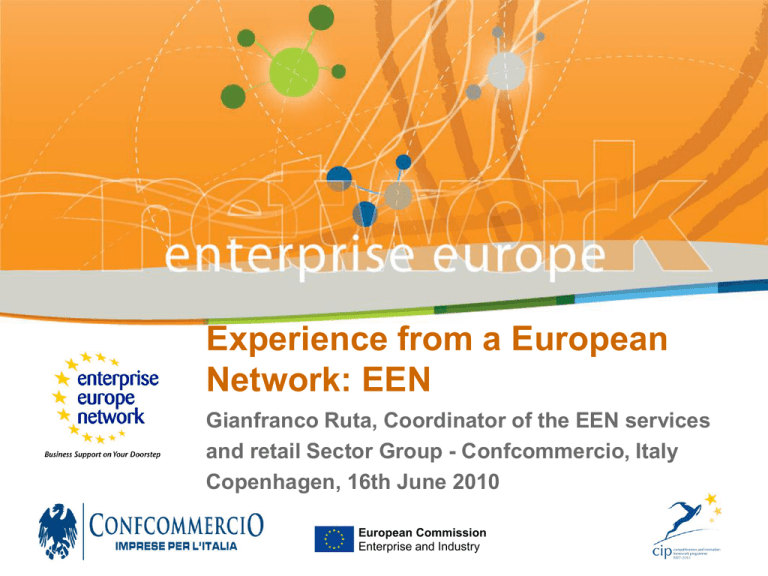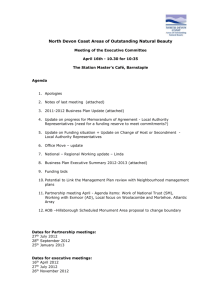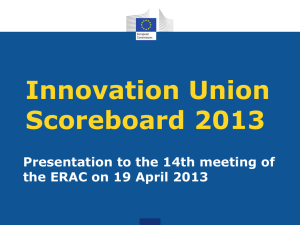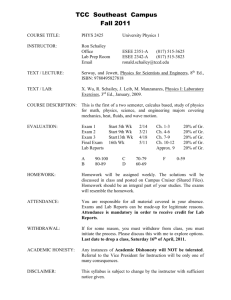RutaCopenhagen_2.1_0
advertisement

Experience from a European Network: EEN Gianfranco Ruta, Coordinator of the EEN services and retail Sector Group - Confcommercio, Italy Copenhagen, 16th June 2010 PLACE PARTNER’S LOGO HERE European Commission Enterprise and Industry Europe INNOVA | 16th June 2010 | 2 TABLE OF CONTENTS 1) Enterprise Europe Network and Sector Group “Services and Retail” presentation 2) The Services Directive 3) Innovation in Services overview 4) Innovation in Services in action New business models assessment Service Design Urban environment and innovation Promoting innovation: the Innovation in Services Award 5) SG work in progress Europe INNOVA | 16th June 2010 | 3 1) Enterprise Europe Network and Sector Group “Services and Retail” presentation Europe INNOVA | 16th June 2010 | 4 Enterprise Europe Network http://www.enterprise-europe-network.ec.europa.eu/index_en.htm “Helping small companies make the most of the business opportunities in the European Union” -The EEN, officially launched on February 2008, brings together business support organisations from across 45 countries. -Members organisations have been working together for years, some even for decades as former Euro Info Centres (EICs) and Innovation Relay Centres (IRCs). -NO WRONG DOOR – ONE STOP SHOP: more than 570 member organisations across EU will either assist SMEs on the spot or put them in touch with a specialised branch in their region even better placed to serve them. -SERVICES: advice and assistance on Technology market; Technology transfer; Access to finance; Advice on EU laws and standards; Intellectual property and patents; Research funding; Going international. Europe INNOVA | 16th June 2010 | 5 Sector Groups http://www.enterprise-europe-network.ec.europa.eu/index_en.htm “Experts in 17 key sectors from all across the Enterprise Europe Network have teamed up to provide you with customised support” •Mainly “inherited” by former IRCs Sector Groups, organise brokerage events to help companies in reaching technology transfer or cooperation agreements with other companies from the same sector. They can also advise on how to find partners to apply for EU-funded joint research projects. •Agrofood; Automotive, Transport and Logistics; Biotech, Pharma and Cosmetics; Chemicals; Creative industries; Environment; Healthcare; ICT Industry and Services; Intelligent Energy; Maritime Industry and Services; Materials; Nano and Microtechnologies; Services and Retail; Space and Aerospace; Sustainable Construction; Textiles; Tourism and Cultural Heritage. Europe INNOVA | 16th June 2010 | 6 Sector Group Services and Retail • A brand new Sector Group born together with the Enterprise Europe Network • Launch meeting: January 2009 • Members from: Italy; Czech Republic; Hungary; France; Poland. • Joining SG members from England; Sweden; Norway. • Not only organising match-making and brokerage events but mainly a door towards EC (DG Enterprise and DG Markt) to focalise needs of services SMEs and to develop EU policies. Europe INNOVA | 16th June 2010 | 7 Sector Group Services and Retail Fields of action and objectives • • • • • • To enhance the co-operation between companies, national and european stakeholders and research centres/universities To create valuable network of SMEs/companies/research centres and universities and stimulate the exchange of best practices and knowledge. To foster the exchange of results and the creation of strategic co-operation with other sector groups To explore and foster innovation in services and retail companies To support companies in order to enable them to benefit more from free movement of services To collect feedback from companies about their experience and problems in free movement/provisions of services. Europe INNOVA | 16th June 2010 | 8 2) The Services Directive Europe INNOVA | 16th June 2010 | 9 Services Directive 2006/123/EC – Principles The freedom of movement of persons, goods, capital and services are the 4 freedoms established by the European Union Treaty (art. 26) The Directive 2006/123 represents the implementation of the principle o freedom of movement of services Concept of Services: Any self-employed economic actvity normally provided for remuneration (Art. 57 TFEU): outside the ties of an employment contract of an economic nature Europe INNOVA | 16th June 2010 | 10 Services Directive 2006/123/EC - Scope Activities included in the Directive It covers all service activities unless they are explicitly excluded Large variety of services covered such as commerce and retailing, construction and crafts, business-related services (consultancy, advertising etc.), most regulated professions, tourism, etc. Covers around 40% of the EU economy Exclusions: financial services, telecommunications, transport services, healthcare service, certain social service, audiovisual service, temporary work agencies, private security services, gambling services, services provided by notaries and bailiffs Europe INNOVA | 16th June 2010 | 11 Services Directive 2006/123/EC - Scope Services should be able to move across national borders as easily as within a single national market: Freedom of establishment of nationals/companies of a Member State in the territory of another Member State (Art. 49 TFEU) Freedom to provide services within the EU across borders without the need for an establishment in the Member State where the service is provided (Art. 56 TFEU) Europe INNOVA | 16th June 2010 | 12 Services Directive 2006/123/EC Services affected by barriers - Why • Barriers arise from national, regional and local regulations as well as from the behaviour of the administration • Lack of confidence between Member States • Barriers arise at every stage of the business process: establishment, use of input necessary for the provision of the service, promotion, distribution and sale, after-sale • Barriers are common to a wide array of activities Need for a framework instrument/Directive Europe INNOVA | 16th June 2010 | 13 The services directive benefits: welfare – employment- market effects of removing barriers to services provision in the Internal Market Economic gains. European consumers, firms and governments will benefit from enhanced productivity, higher employment and increased wages. The gains are explained by the impacts of stronger competition and reduced costs in the EU service sectors. Prices of services is going to fall. Stronger competition will reduce artificially inflated prices and less waste of resources will lead to lower costs of services provision. Productivity gains enable the creation of higher value added and provide a strong stimulus also towards innovation to the EU economy. Europe INNOVA | 16th June 2010 | 14 The Services Directive benefits Output will rise in all sectors of the EU economy. Output and value added will increase across all sectors, and services and goods market will expand considerably .The increase in economic activity will spur the creation of new jobs mainly in those sectors where the barriers are reduced the most. Business will experience increased opportunities in the Internal Market as international expansion becomes less costly Trade in services will intensify. Service provision through both cross-border trade and foreign commercial establishment will increase and promote competition. Source: “Economic Assessment of the Barriers to the Internal Market Services – Copenhagen Economics, January 2005 – Economic Trade Model CETM Europe INNOVA | 16th June 2010 | 15 The Services Directive and the SG activity Improving the Service Directive awareness and knowledge within the Enterprise Europe Network by: - training sessions - documents and guides - discussion of practical cases - feedbacks to the European Commission on the Directive’s implementation According to the Directive (art. 21.2) the “Points of Single Contact” and the EEN desks are the organisations supporting businesses in obtaining information on the Directive Europe INNOVA | 16th June 2010 | 16 The Services Directive and the SG activity Example of cases covered by the Service Directive - An Italian company specialised in managing cultural projects (museums, private foundations, municipalities culture centres) would like to run a private artistic and cultural centre in France where a previous authorisation is required. - A Polish architect established in Warsaw is commissioned to design a hotel in Berlin, Germany and as part of this task will be active once a month in Berlin. For this reason the architect would like to set up an office in Berlin. Europe INNOVA | 16th June 2010 | 17 Sector Group Services and Retail Services Directive training session The Services Directive as innovation driver for the whole European service sector Decentralised training session for EEN members organised by Confcommercio and SG members (Rome, 6th-7th May 2010) Speakers from EC – DG Markt and Enterprise; Italy, France, Hungary; Czech Republic; Poland Contents: main benefits and State of implementation in EU; sharing of experience about National state of implementation after 28th December 2009 deadline; crossborder provision of services; VAT rules applying for provision of services within EU from 1st January 2010 Work in class: discussion of cases Around 30 delegates participating from across EU Documents soon available for EEN members in First Class – Conferences – Sector Groups – Services and Retail Europe INNOVA | 16th June 2010 | 18 3) Innovation in services: quick overview Europe INNOVA | 16th June 2010 | 19 Innovation in services concepts Multiple concepts • • • • • • • • • Technology-based (Pavitt, Barras, RPC, Reverse Product Cycle) Dimensional integration (service components mix: Den Hertog) Knowledge-based (Galouj, Rullani) Collaboration-oriented (Service Dominant Logic vs. Good Dominant Logic Service process modelling/engineering (Shostack, Blueprinting, SSME) Service Design (see paragraph) Environment/Systemic-centred (territory, clusters, business networks, innovation ecosystem) Lean Thinking applied to services Hidden-innovation (e.g. new organisational forms, new business models, etc. - NESTA, UK) Europe INNOVA | 16th June 2010 | 20 Innovation in services approaches Different approaches • Assimilation: Innovation in services models stem from innovation in goods models • Demarcation: Innovation in services as specific case • Integration (services & goods): Innovation model valid for goods & services Europe INNOVA | 16th June 2010 | 21 Innovation in services definitions Several definitions New or significantly improved service concept that is taken into practice. It can be for example a new customer interaction channel, a distribution system or a technological concept or a combination of them. A service innovation always includes replicable elements …. A service innovation benefits both the service producer and customers and it improves its developer’s competitive edge (TEKES, 2007) New or considerably changed service concept, client interaction channel, service delivery system or technological concept that individually, but most likely in combination, leads to one or more (re)new(ed) service functions that are new to the firm and do change the service/good offered on the market and do require structurally new technological, human or organizational capabilities of the service organization (Van Ark, 2003) Europe INNOVA | 16th June 2010 | 22 R&D&I State aid Framework European Commission R&D&I State aid framework (2006/C 323/1) 5.5. Aid for process and organisational innovation in services Definition: « innovation less systematic which stems frequently from customer interaction, market demand, adoption of business and organisational models » Requirements: • use and exploitation of ICT • formulation as a project with a qualified project manager • development of a standard, of a business model, methodology or concept, which can be systematically reproduced and possibly patented • novelty in EU • clear degree of risk Europe INNOVA | 16th June 2010 | 23 Innovation in Services: what it can be assumed (points of discussion) 1) 2) 3) 4) 5) 6) Technology is “just” an important enabler Cross-disciplinary knowledge and competences are strongly needed in every innovation project (technology, economy and management, fine arts, sociology and humanities, example the “T” model from IDEO) The boundaries between manufacturing and services are blurring (think to Apple “i” philosophy) R&D isn’t the unique driver for innovation (reverse innovation value chain) Customers, employees, suppliers (and competitors) are essential sources for innovation Metrics used to assess innovation are still biased to science-based concepts Europe INNOVA | 16th June 2010 | 24 Innovation in Services: what can be assumed (points of discussion) 7) Hidden innovation is one of the main form of innovation in many service sectors 8) It should be considered the opportunity to define sector-based innovation metrics 9) Productivity in services is underestimated for similar reasons (intangibles are not considered, TFP concept to be reconsidered) 10) Innovation in services is multidimensional (service concept, customer interface, delivery system, technology) 11) Service Design is one of the more promising approach (since is holistic by definition) 12) Sharing of knowledge and skills are driving forces to develop innovation either in manufacturing or in services Europe INNOVA | 16th June 2010 | 25 Innovation in Services: what can be assumed (points of discussion) 13) Business networks, clusters, regulatory framework and infrastructures are the basic environment to develop and to apply innovation (innovation ecosystem) 14) Business models and financial sustainability are generally underestimated aspects by the “innovators” (and policy makers) 15) Theory is quite abundant whereas there are too few studies/surveys on “real world”, examples and best practices to share. How EEN SG “Services & Retail” can assist SMEs, possible cases: Europe INNOVA | 16th June 2010 | 26 4) Innovation in Services in action: sharing ideas, connecting people Europe INNOVA | 16th June 2010 | 27 Innovation in Services in action: sharing ideas, connecting people SG lines of activity: similar to those of Service Directive and – specifically – the combination of knowledge improvement and technical assistance focused on: - Business modelling, design and management tools in services - Skills and competences - Emerging technologies - Best practices & Public policies Europe INNOVA | 16th June 2010 | 28 Building a knowledge base on innovation in services: examples Methods/Concepts New business models assessment Service Design Management (business networks, lean thinking) Skills and qualifications Town management & services Virtual communities (and the Wiki approach) Emerging Technologies & applications Mobile commerce RFID QR codes Digital signage Green tech (in service activities) Best Practices Best practices in the service sector (e.g. new format/concepts in retail Industry) New public policies (support schemes, innovationby-law cases, etc) Europe INNOVA | 16th June 2010 | 29 EXAMPLES/1 Innovation in sevices: new business models pattern A (self-)assessment tool Europe INNOVA | 16th June 2010 | 30 New business assessment: the SENC model (E. Rullani, Venice International University) COMPLEXITY al lob ce rvi e s Spe Complexity: flexibility and readiness to include customers’/partners’ needs in supply value proposition cial izza tion G Co mm un it y g nin e tio anc nc Fu rform pe SOCIALIZATION ivid se -m ak Ind ing EXPRESSIVENESS Se n ual Org ani zat ion ork w t Ne NETWORKING Expressiveness: capability to generate original sensemaking for customers Socialization: creation / promotion of common values and identities among customers Networking: intervention of formal or informal networks, in order to support the offering system coming from the exploration of the other three factors (according to the company’s strategy) Europe INNOVA | 16th June 2010 | 31 SENC model: breaking the value Vs. volume tradeoff V, value (customization) New lines for innovation Global service Innovation in Niche excellences services area Access (outsourcing) New welfare Connectors ‘Neo’ services Personal and social connections Meanings (‘intangible’ values) Flexible modules Traditional services sector Standard Connective services ‘Neo’ Industry Massive industry TradeTrade-off line Value vs. Volumes N, Number (Volumes) Source: Innovation in services – The Retail case – G. Ruta - European TrendChart Workshop June 19 and 20, 2006 - Porvoo, Finland Europe INNOVA | 16th June 2010 | 32 SENC Model: where you are and what are you going to implement global services, which help customers to identify their real needs in partnership and which include comprehensive solutions; niche excellences, mainly based on quality and on a unique market positioning; access (activities performed ‘on demand’), as it is the case of outsourcing allowing producers to focus themselves on their core competences and business; new welfare, which gives an answer to the new sociodemographic dynamics (ageing population, etc.); connectors, which are, for example, technological connectors (enablers), industrial clusters; Source: Innovation in services – The Retail case – G. Ruta - European TrendChart Workshop June 19 and 20, 2006 - Porvoo, Finland Europe INNOVA | 16th June 2010 | 33 SENC Model: breaking the value Vs. volume trade-off personal, business and social networks, which is for example the way of sharing knowledge improving mutual trust; meanings (value dimension) one of the most important aspects of most services activities, namely retailing, where ‘concepts’ and ‘formats’ are centred on the ‘intangible’ dimension of ‘shopping experience’; flexible modules, looking for a modularity which reduces costs, preserves customization possibilities and flexibility to the market demand; standard, which means taylorism as a model aimed at transforming traditional services in high standardized, highvolume services (e.g. self-service). Source: Innovation in services – The Retail case – G. Ruta - European TrendChart Workshop June 19 and 20, 2006 - Porvoo, Finland Europe INNOVA | 16th June 2010 | 34 SENC Model (50 cases of innovation in services) Innovation classification model Business area Innovation drivers External (environment) Internal Top-quality food & beverage Niche excellence; Meanings Skilled personnel Suppliers Marketing; organization; people, suppliers Logistic Connectors Institutions (*), Technology, management(**),competitors, customers Strategy, marketing, ICT, Organization, customers Tax-free shopping Connectors, Flexible modules Technology, management, competitors, public administration (P.A.) Organization, ICT, people, finance Cultural foundation Personal and social networks, Meanings Management, society (***) customers, P.A. Strategy, marketing, ICT, people Outlet design & management Personal and social networks, Meanings Professionalism, society management, customers Organization, people Restaurant chain Meanings, Flexible modules Management, society, customers Strategy, marketing, ICT organization, suppliers Book shop chain Meanings, Flexible modules Technology, management, society, customers Strategy, marketing, organization, people Fashion shops (glasses) Meanings, Flexible modules, Standards Management, society, competitors, suppliers Strategy, marketing, organization Meanings, Flexible modules, Standards Institutions, technology, society, customers, P.A. Strategy, marketing, organization, people Highway/Rail/Airport restaurants chain bar & Europe INNOVA | 16th June 2010 | 35 Europe INNOVA | 16th June 2010 | 35 EXAMPLES/2 Service Design This chapter on Service Design is courtesy of Andrea Granelli - www.kanso.it Europe INNOVA | 16th June 2010 | 36 Design thinking PROFICIENCIES APPROACH • INDUCTIVE APPROACH TO INNOVATION (start from a specific problem) Economics • FOCUS ON HOW OTHER THAN ON WHAT (make the thing right not only the right thing) • COMMUNICATE THROUGH PROTOTYPES, NOT WORDS (efficient way to judge features and ideas) Humanities Technique • OBSERVATION IS INSPIRATION (acquire insight to get creative ideas) • LET A WAY OPEN TO SERENDIPITY (sometimes good ideas come by chance) Design Thinking defines as specific features of design a set of mixed proficiencies and an approach to innovation based on observation, pragmatism and problem solving attitude. These elements, no more exclusive for designers, become more and more relevant and part of companies' cultural heritage Europe INNOVA | 16th June 2010 | 37 Design thinking BUSINESS SCHOOL DESIGN SCHOOL • Projects starts with a focus on market size, using financial analysis to understand it • Project starts with a focus on consumer, using ethnographic analysis to better understand their characteristics • The aim is to develop just one product to sell • The aim is to develop appealing prototypes • Production starts on first good idea completion • Prototyping process is reiterated, resulting in a plenty of “winners” • Cornerstones: control and technology • Cornerstones: anthropology, creativity and a true obsession with consumers' “unmet needs” BUSINESS THINKING promotes innovation while allowing business opportunities DESIGN THINKING Design evolved from a discipline regarding form&function to a new approach, focused on developing business models Europe INNOVA | 16th June 2010 | 38 Design phases INSPIRATION 1. OBSERVATION • •Psycologists, anthropologists and market research experts works together to understand customer experience and consumers' problems 2. BRAINSTORMING IDEA 3. PROTOTYPING EXECUTION 4. REFINING Intense idea• Prototype creation • Narrows solution generation helps available number down to sessions, starting solution display few choices from data collected promoting feature observing people. definition and Brainstorming usability sessions follow troubleshooting well defined rules •Variety of proficiencies •Consumer observation through new techniques •Search for inspiration sources •Environment favorable to idea generation •Well defined brainstorming rules •Prototype creation •Focus on core problems •Seek aid by consumers •Find solutions 5. IMPLEMENTATION • An integrated team made up by engineers, designers and problem-specific experts, creates the product or service •Joint effort between engineers, designers and problem-specific experts Europe INNOVA | 16th June 2010 | 39 Design tools INSPIRATION 1. OBSERVATION 2. BRAINSTORMING • Final choices •Shadowing delay (hidden consumer observation) • Analysis of previous ideas •Behavioral maps as bases •Extreme users • Noninterviews conventional •Storytelling thinking •“Unfocus” groups promotion • New ideas promotion • Visual thinking • Solid topic boundaries • Oneconversation ata-time rule EXECUTION IDEA 3. PROTOTYPING • Single project parts prototyping • Photos and videos • Speed • Focus on core problems • Scenarios • Personas 4. REFINING • Prototype discussion • Customer involvement • Discipline • Obtaining consensus 5. IMPLEMENTATION • Whole team involvement (even in technical-specific phases) Europe INNOVA | 16th June 2010 | 40 Service Design • The increasing relevance assumed by the service sector in terms of people employed and value added created, makes crucial a careful planning Touchpoint at Poste Italiane • Service Design consists in the planning and organization of services – their elements, people involved, necessary infrastructures, way of communication, material and management aspects, valuable elements - with the aim of improving the quality of services and maximizing the fruition experience. • In the design of a service a particular importance is covered by the design of the interface, that is the place of the contact, the area in which interactions between services (social – technical artefact) and the user take place. The SensitiveWall developed for Poste Italiane Europe INNOVA | 16th June 2010 | 41 Customer interface The concept of service interface: the area where the interaction between supply system and customers happens The interaction project is the systematic and fitting organization of all the physical and human elements of the interface customercompany needed to implement the supply of services under established standards of quality Europe INNOVA | 16th June 2010 | 42 Service Design and the consolidated models/1 The four-dimensional model of service innovation al on ati s nis ilitie ga Or apab c Technological options (Dimension 4) New service delivery system (Dimension 3) New customer interface (Dimension 2) Characteristics of actual and potential clients New service concept (Dimension 1) Marketing & distribution capabilities H Man uman R age men esour t ca ces pab ilitie s Characteristics of existing and competing services Pim den Hertog, Bilderbeek (1999) - Dialogic© Europe INNOVA | 16th June 2010 | 43 Service Design and the consolidated models/2 Europe INNOVA | 16th June 2010 | 44 Service Design principles • Sharing of language: the language and the conventions adopted must be consistent as in form than contents, it must be attributed a unique and definitive meaning • Sharing of valuable codes: to be used, the service must base its codes on a platform of shared social values. • Accessibility: the language has to be adapted to the physiological and cognitive mechanisms of human user • Visibility of the service: in order to use a service it is essential to know that it exists, what it supplies and how it works • Orientation: To be able to use a service the user should use a correct mental pattern of use • Transparency: the concept of transparency refers to the ability of the service to make the user aware of the course, timing and outcome of the process • Feed-back: the ability of an interactive system to provide confirmation or denials in relation to the proper receipt of the input entered by the user • Opt out: the system must allow freedom of exit, for example, the freedom to stop or cancel the transaction • Error-friendliness: the interface of the service should allow the user to make mistakes without compromising the outcome of the operation Europe INNOVA | 16th June 2010 | 45 Service Design: not only shopping malls or banks The access gate to archaelogical Rome The Access Gate represents the digital and physical "privileged" point of departure from which tourists, citizens and students begin to explore the city, its monuments and artefacts joined in different circuits with different narrations It has three main tasks: • Narration and preparation (also in an emotional way) of the visit • Destination management tool for the enhancement of the visit • “Outdoor laboratory”, to test infrastructures, services and business models that involves visitors not only in the validation process but, also, in the planning phase and that permits a permanent observation of behaviors and preferences of users Europe INNOVA | 16th June 2010 | 46 Service Design: design and users • EXPERIENCE becomes the new planning paradigm • NARRATION gives meaning to the performance • INTERFACE becomes more and more important DESIGN becomes the (new) method to join these factors in an harmonic, cost-effective and environmentally friendly way. For more information on Service Design: www.service-design-network.org Europe INNOVA | 16th June 2010 | 47 PLACES SEEMED TO HAVE LOST THEIR ECONOMIC RELEVANCE … • In the last fifty years, the experts of the American urban society believed that cities had entered into an inexorable phase of decline; to quote George Gilder “Large cities are the forgotten legacy of the industrial era”. • Often it was said that in a highly technological period “geography is dead" and the place where individuals work are no longer important. Europe INNOVA | 16th June 2010 | 48 … BUT THEY ARE RESUMING A CENTRAL ROLE IN THE SERVICE ECONOMY • They attract talents: “beautiful places” go back to their traditional role as generators of economic value. • They multiplie the objects it contains: “Our most invaluable cultural heritage is the framework, the continuum linking monuments, cities and individuals; the framework includes not only museums and monuments, but also the culture of conservation that have allowed them to survive up to our time” (Salvatore Settis). • They contributeto intellectual protection: it gives its products a historic connotation, a specific difference, the feeling that they cannot be easily imitated from outside. Europe INNOVA | 16th June 2010 | 49 The role of cities in the service economy • Cities (and innovating groups living in them) need specific infrastructures to “catch” the economical potential that may be produced • Such infrastructure should be planned through a “General territorial business plan ” integrating etherogeneous or otherwise ignored planning aspects • These tools should allow a planning capable to integrate either material or virtual aspects Europe INNOVA | 16th June 2010 | 50 The limits of classic urbanistic method • The interventions on cities have been made, quite often, in an episodic way and with regulatory, procedural and planning instruments inadequate to the necessary rational transformation of the city. • It is often forgotten that the purpose of the urban planning process is to improve the quality of life of persons. They need to move and operate in "places" where not only they can, as users, to carry out the necessary activities, but where they feel, as citizens, at ease and where they recognize themselves as part of a specific community with which they share history, traditions and culture. The planning process, in “the most successful cases”, has pursued the efficiency and effectiveness improvement of the urban "machine" through partial and not homogeneous interventions on different urban zones. • General regulatory Plans, urban requalification Projects, traffic and mobility Plans have often been made without considering carefully the structure and logistical requirements of the existing trading systems. • The difficult coexistence among the different souls of the city • The need of multidisciplinary skills and specific planning capabilities Europe INNOVA | 16th June 2010 | 51 An integrated plan to allow each soul of a given city to emerge and coexist with other ones is needed • The citizens' city • The ancient city • The city of business • The tourists' city • The digital city • The market city • The city of transports • The creatives' city • The dreamt city • The elderlies' city • … Europe INNOVA | 16th June 2010 | 52 THE NEED OF MULTIDISCIPLINARY SKILLS AND SPECIFIC PLANNING CAPABILITIES The “planning ability” of the city needs multidisciplinary skills (urban, sociological, technological, legal, geographical, business, engineering, computer scientists...) and activities (continuous monitoring of data, correct identification of the phenomena, definition of the intervention areas...) that go beyond the current municipal competences TECHNOLOGY, DESIGN, URBANISTIC …. Live innovation for everyday Life ! Europe INNOVA | 16th June 2010 | 53 EXAMPLES/4 Public policies The Innovation in Services Award Europe INNOVA | 16th June 2010 | 54 Promoting Innovation in Services: The Innovation in Services Award Aimed at recognising the services as a sector able to develop an innovation pathway even more important for revitalizing the economic system. Who can participate open to all firms in the services sector: single Italian enterprises or partnerships composed of European or international firms or associated to professionals, public and private research institutes. Award categories: • Innovation in Commerce (retail&wholesale, 1 award) • Innovation in Tourism (1 award) • ICT & Service Design (open to all service sectors, 2 awards) THE PRIZE IS PURELY HONORIFIC. THE WINNER IS AWARDED BY THE PRESIDENT OF THE ITALIAN REPUBLIC Europe INNOVA | 16th June 2010 | 55 The Innovation in Services Award Evaluation criteria General criteria of merit taken into account: • Quality of innovation, replicability of the model, positive impact on the chain of ownership and on the socio / environmental, reliability and financial credibility of the proposal; • Innovation and strategic relevance of ICT; • Innovativeness of the design methodologies used and their consistency with the principles of Service Design and Service Science Management and Engineering. 2010 (2nd edition) evaluation grid - organisation, technology, customer care, business model; - aspects of supply chain and of relations with the territory, with particular reference to the urban areas; - presence of enterprise network (mainly SMEs); - social impact and environmental sustainability; - ITC: level of technological innovation and impact on service system; - Service Design: aesthetic, functional and integrative quality of touchpoints Europe INNOVA | 16th June 2010 | 56 The Innovation in Services Award Presented projects by category 45 40 35 30 25 20 15 10 5 0 Commerce Tourism 2009 2010 ICT&Service Design Europe INNOVA | 16th June 2010 | 57 The Innovation in Services Award Presented project by type 80 70 60 50 40 30 20 10 0 2009 Web 2.0 2010 Other ICT New format/concepts Business netw orks Other non-ICT Europe INNOVA | 16th June 2010 | 58 5) Sector Group Services and Retail The work in progress Europe INNOVA | 16th June 2010 | 59 SG work in progress Collecting and sharing innovation in services best practices - focusing on new enabling technologies (mobile communications broadband, RFID, touch screens, new materials, new tools, etc); - organizational techniques and processes (aimed to efficiency or to innovation management, etc.); - service Design methods and applications - vertical and horizontal Business Networks (specially of SMEs) - human capital and skills improvement - new business models - urban environment and innovation Deliverables A) Newsletter (1st number in September 2010) B) Meetings (Autumn meeting on process modelling in hotel/restoration) C) Forums Europe INNOVA | 16th June 2010 | 60 THANK YOU ! for more information on the SG Services and Retail please contact Stefania Foresi at s.foresi@confcommercio.it








